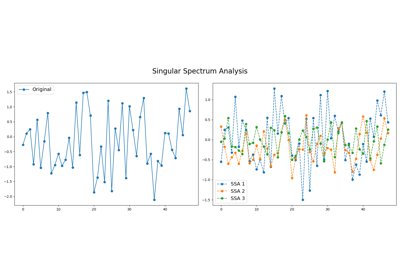pyts.decomposition.SingularSpectrumAnalysis¶
-
class
pyts.decomposition.SingularSpectrumAnalysis(window_size=4, groups=None)[source]¶ Singular Spectrum Analysis.
Parameters: - window_size : int or float (default = 4)
Size of the sliding window (i.e. the size of each word). If float, it represents the percentage of the size of each time series and must be between 0 and 1. The window size will be computed as
max(2, ceil(window_size * n_timestamps)).- groups : None, int or array-like (default = None)
The way the elementary matrices are grouped. If None, no grouping is performed. If an integer, it represents the number of groups and the bounds of the groups are computed as
np.linspace(0, window_size, groups + 1).astype('int64'). If array-like, each element must be array-like and contain the indices for each group.
References
[Rf17d82cd0544-1] N. Golyandina, and A. Zhigljavsky, “Singular Spectrum Analysis for Time Series”. Springer-Verlag Berlin Heidelberg (2013). Examples
>>> from pyts.datasets import load_gunpoint >>> from pyts.decomposition import SingularSpectrumAnalysis >>> X, _, _, _ = load_gunpoint(return_X_y=True) >>> transformer = SingularSpectrumAnalysis(window_size=5) >>> X_new = transformer.transform(X) >>> X_new.shape (50, 5, 150)
Methods
__init__(self[, window_size, groups])Initialize self. fit(self[, X, y])Pass. fit_transform(self, X[, y])Fit to data, then transform it. get_params(self[, deep])Get parameters for this estimator. set_params(self, \*\*params)Set the parameters of this estimator. transform(self, X)Transform the provided data. -
__init__(self, window_size=4, groups=None)[source]¶ Initialize self. See help(type(self)) for accurate signature.
-
fit_transform(self, X, y=None, **fit_params)¶ Fit to data, then transform it.
Fits transformer to X and y with optional parameters fit_params and returns a transformed version of X.
Parameters: - X : numpy array of shape [n_samples, n_features]
Training set.
- y : numpy array of shape [n_samples]
Target values.
- **fit_params : dict
Additional fit parameters.
Returns: - X_new : numpy array of shape [n_samples, n_features_new]
Transformed array.
-
get_params(self, deep=True)¶ Get parameters for this estimator.
Parameters: - deep : bool, default=True
If True, will return the parameters for this estimator and contained subobjects that are estimators.
Returns: - params : mapping of string to any
Parameter names mapped to their values.
-
set_params(self, **params)¶ Set the parameters of this estimator.
The method works on simple estimators as well as on nested objects (such as pipelines). The latter have parameters of the form
<component>__<parameter>so that it’s possible to update each component of a nested object.Parameters: - **params : dict
Estimator parameters.
Returns: - self : object
Estimator instance.
-
transform(self, X)[source]¶ Transform the provided data.
Parameters: - X : array-like, shape = (n_samples, n_timestamps)
Returns: - X_new : array-like, shape = (n_samples, n_splits, n_timestamps)
Transformed data.
n_splitsvalue depends on the value ofgroups. Ifgroups=None,n_splitsis equal towindow_size. Ifgroupsis an integer,n_splitsis equal togroups. Ifgroupsis array-like,n_splitsis equal to the length ofgroups. Ifn_split=1,X_newis squeezed and its shape is (n_samples, n_timestamps).


